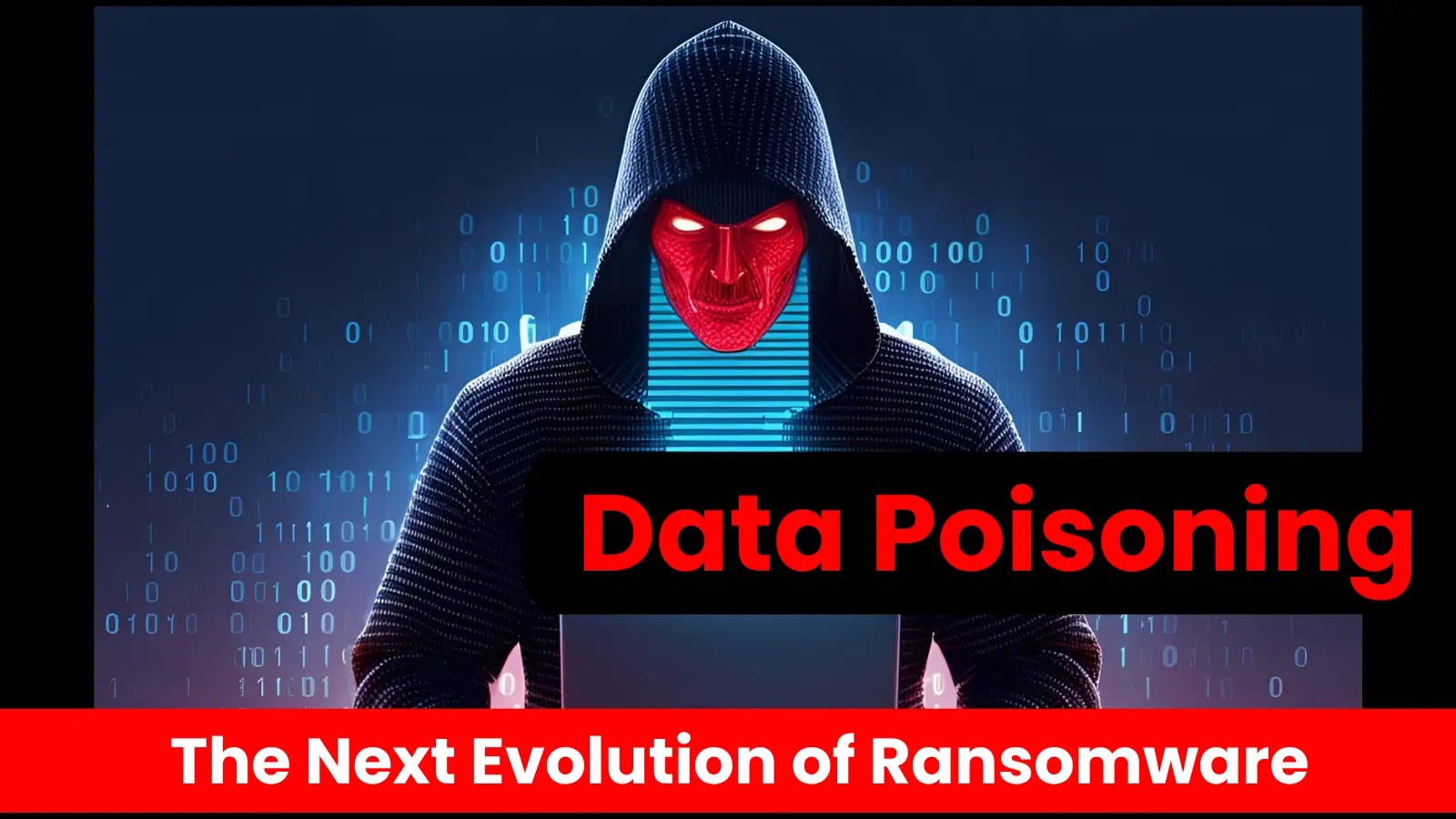For many years, ransomware has been associated with online extortion, causing businesses to become immobilized as they attempt to recover encrypted data.
With cybersecurity teams preparing for these direct attacks, organizations have become accustomed to the risk of frozen systems and locked databases.
However, a new and much more pernicious threat is showing up that does more than just prevent access to data; it also alters it without leaving any overt indications of compromise.
The future of ransomware lies in reality-distortion rather than denial of service. Consider the financial turmoil that would result from a company’s records being covertly changed to prevent audits.
Imagine the chaos that would result from rewriting patient histories, which would result in incorrect diagnoses and treatments. Nothing would be safe, including scientific research, contracts, and even legal evidence.
Data poisoning, a ransomware evolution, is intended to undermine trust at its core and is extremely difficult to detect due to its stealthy nature.
Such an attack has far more ramifications than just being inconvenient. They signify a fundamental breach of digital integrity, for which organizations are completely unprepared.
Understanding Data Poisoning: A Silent but Lethal Threat
Picture this: You wake up one morning, check your bank account, and see an overdraft fee for a transaction you don’t remember making. Panic sets in.
Did someone steal your card details? You frantically scan through past statements, only to realize that some of your transactions don’t match what you recall.
Your trust in your own financial records crumbles in an instant. Now, scale that scenario to an entire corporation. That’s what data poisoning can do.
How Data Poisoning Works
In contrast to conventional ransomware, which blatantly prevents users from accessing their systems, data poisoning is patient, skillful, and subtle.
Rather than using force, it uses a whisper—subtle changes that are initially invisible. A name has a small misspelling, a date changes, and a decimal point moves.
These minor distortions gradually spiral out of control. How can you even start identifying the origin of the corruption?
Hackers wielding this tactic don’t need to demand a ransom immediately. They wait, letting confusion build until their victims have no choice but to negotiate.
A hospital’s patient records, once sacred and precise, might now recommend the wrong blood type. A scientist’s groundbreaking study, years in the making, could suddenly become invalid due to minuscule alterations in raw data. Who would notice before it’s too late?
Why Data Poisoning Is Becoming More Common
This form of attack is gaining traction for several reasons. First, the rise of artificial intelligence and machine learning has created an overreliance on automated decision-making.
Many organizations trust their algorithms to process financial reports, control inventory, or even diagnose diseases. Poisoning the input data undermines the output, causing cascading failures across an entire infrastructure.
Why Trust Is the New Currency for Cybercriminals
Cybercriminals have realized that trust is a more valuable currency than locked files. By merely altering data instead of outright blocking it, attackers can avoid triggering immediate defensive countermeasures.
The fact that victims might not even be aware that an attack has taken place leaves them vulnerable to more abuse.
Assuming that data integrity is an afterthought, companies continue to concentrate their cybersecurity efforts on preventing malware infections and data breaches.
Because they are ill-equipped to identify and stop data manipulation attacks, traditional cybersecurity defenses like firewalls and endpoint protection are a prime target for hackers trying to take advantage of blind spots.
The Devastating Real-World Consequences of Data Manipulation
As opposed to ransomware that uses encryption, which disrupts operations, data poisoning results in long-term, systemic instability.
The harm is frequently irreversible since tainted records result in poor business choices, monetary losses, and even legal repercussions.
If transaction logs are tampered with, a bank might unknowingly approve fraudulent transactions or fail to detect discrepancies until millions of dollars have vanished.
Auditors, unable to distinguish real records from poisoned ones, could inadvertently approve fraudulent reports, leading to regulatory penalties and reputational damage.
Healthcare: The Deadly Risks of Compromised Records
In healthcare, the stakes are even higher. If patient medical histories are altered—medications changed, allergies removed, diagnoses fabricated—the consequences could be fatal.
Doctors relying on manipulated data might prescribe incorrect treatments, leading to unnecessary complications or even loss of life.
Legal and Government Records: A Crisis of Trust
Legal and government records are equally vulnerable. A single alteration in court documents could change the outcome of a trial.
Tampering with property records might lead to fraudulent ownership claims, while falsified scientific research could disrupt years of progress in fields like medicine and engineering.
The consequences are not just digital—they are deeply embedded in the real world.
The Role of Digital Verification in Combating Data Poisoning
Imagine you’re a business owner signing an important contract. You glance over the details, double-check the figures, and confirm everything looks correct.
But what if, somewhere in the process, a crucial clause was altered—just subtly enough to go unnoticed? By the time you realize it, it’s too late. This is the insidious nature of data poisoning. How do we fight it?
Secure QR Codes and Other Verification Tools
One promising solution is digital verification. Secure QR code generators, like those offered by Uniqode’s online QR codes, are one way companies can ensure the authenticity of their data.
Think of it as a digital fingerprint that verifies whether a document, transaction, or dataset is truly what it claims to be. If any unauthorized change occurs, the system flags it instantly.
Wouldn’t it be reassuring to know that even in a world where digital deception is on the rise, your business had an extra layer of protection? While no single tool can completely eliminate cyber threats, integrating verification measures like these can significantly reduce the risk of falling victim to data poisoning.
Defending Against Data Poisoning Attacks
As organizations become aware of the looming threat of data poisoning, they must rethink their security strategies. Traditional defenses are not enough—new approaches must be adopted to ensure data integrity at every level.
- Implementing Data Provenance and Audit Mechanisms: Companies must enforce stringent verification processes for all data modifications. This includes cryptographic hashing, blockchain-based record tracking, and automated logging systems to flag unauthorized changes in real time.
- Strengthening Access Control and Insider Threat Detection: Many data poisoning attacks originate from within organizations, either through malicious insiders or compromised accounts. Strengthening identity and access management (IAM) policies, enforcing multi-factor authentication (MFA), and monitoring employee behavior can mitigate risks.
- Leveraging AI for Anomaly Detection: Just as cybercriminals exploit AI, defenders can use machine learning models to detect unusual patterns in datasets. These systems can identify discrepancies that deviate from expected norms, raising alarms before damage becomes widespread.
- Regular Data Backups and Integrity Checks: While backup solutions are standard practice against ransomware, they are often underutilized for data integrity verification. Conducting periodic integrity checks and maintaining immutable snapshots of critical databases can provide a reliable reference point for identifying and reversing data manipulations.
The Future of Cybersecurity: A War on Trust
Data poisoning signals the beginning of a new phase of cyberwarfare that threatens not only systems but also the foundation of reality in our digital society.
In contrast to conventional ransomware, which causes victims to recognize an attack right away, data poisoning enters undetected and fundamentally changes important data.
There are serious repercussions when businesses unintentionally base decisions on fabricated data, including compromised government records, medical safety, and financial stability.
To combat this changing threat, businesses need to make investments in anomaly detection, real-time monitoring, and verification technologies.
Nowadays, maintaining the integrity of the data is just as important as safeguarding it. How can governments, corporations, and individuals function with confidence if data is no longer reliable? A future where every choice, transaction, and record is accompanied by the unsettling question: Can we trust what we see? This is what will happen if we do not take immediate action.


.png
)


